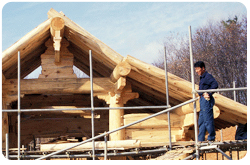Intangible Cultural Heritage of Humanity
Intangible Cultural Heritage of Humanity- Republic of Korea
-
Daemokjang, traditional wooden architecture
Master Carpenter with Superb Expertise
Daemokjang Leads Wooden ArchitectureA house is where a family lives. But it also serves as a marker of its owner’s social status and wealth. That seems to explain why many palaces, residences of noble families, and Buddhist temples were built to be more majestic and imposing than the others. In the past, all the Korean houses, whether it was a royal palace, a Buddhist temple or a commoner’ house, were wooden structures. 
The construction of a traditional wooden building goes through a number of processes. First, the construction begins with the purchase of timber, layout planning and structural designing. Next, the wood is cut into various beams and columns, and the framework is completed. Then, the walls are put up, the roof is covered with tiles, and some parts of the surfaces are painted with colorful designs. Naturally, larger houses need heavier wooden beams and roofs, and the frameworks also have to be stronger.
Traditional woodworking techniques, including the skill to connect wooden beams, require a long period of training to master. Also the carpenter should have a comprehensive knowledge of various tools and the ability to use them skillfully. Therefore, skilled carpenters are produced through decades of apprenticeship and field experience.In traditional Korean architecture, joiners and carpenters had distinctively different responsibilities. Joiners (somok) worked on small-scale woodworks, such as doors, railings, parts for sculpting and furniture, while carpenters (daemok) built the framework of a building, consisting of columns, beams, rafters, angle rafters, lintels, bracket systems, etc. A person responsible for the entire field of woodworking was a master carpenter (daemokjang), who also headed all the artisans involved in the entire construction procedure 
- tile makers, repairers, masons, plasterers, ornamental painters, and others. Carpenters who built palaces or fortresses were the highest class of carpenters, and were treated with prestige. There were times when the court carpenters were given government positions.
In the 18th century, however, the court carpenters no longer held government positions. Their job title was changed into pyeonsu, and master carpenters called dopyeonsu supervised the construction of government buildings and temples. Compared to the earlier title daemokjang, the new title denoted the lowered social status of carpenters, and this may be attributable to the rise of Confucianism in the Joseon Dynasty, which placed academic learning ahead of martial arts and practical skills. Regardless of their changed status, master carpenters and other artisans in many fields pursued perfection in their arts, and left timeless masterpieces for their descendants to inherit.
The institution of appointing master carpenters in traditional Korean architecture is Korea’s first technical field to be inscribed on the list of UNESCO’s Intangible Cultural Heritage of Humanity. Its inscription is more meaningful in that master carpenters are the ones who supervised the restoration of Changdeok Palace, which is a World Heritage site, as well as Gwanghwamun, the main entrance of Gyeongbok Palace, and Sungnyemun, the southern gate to the old capital city Seoul.



 >
>